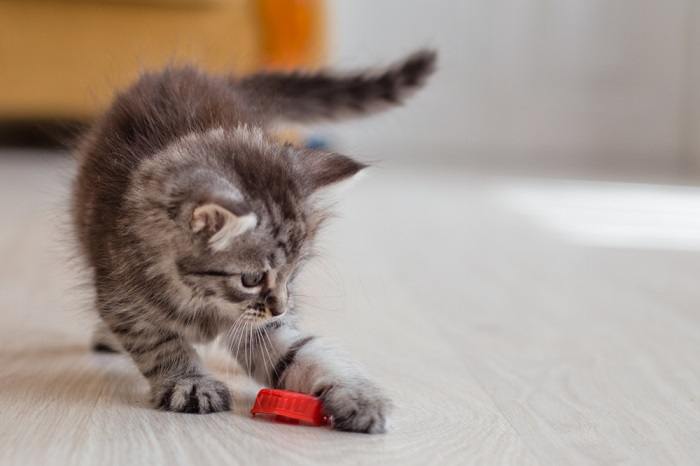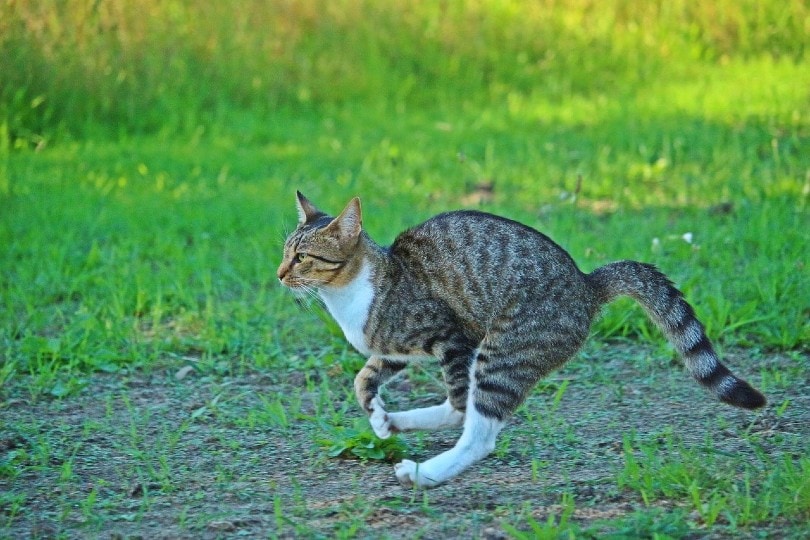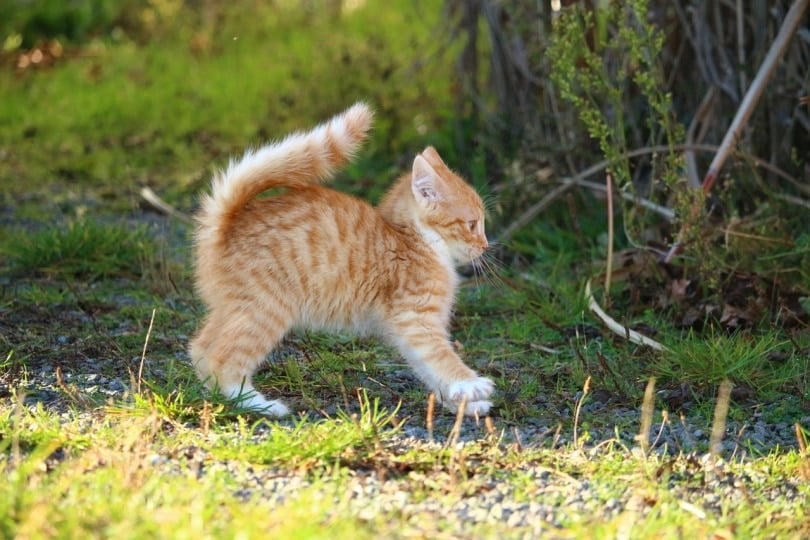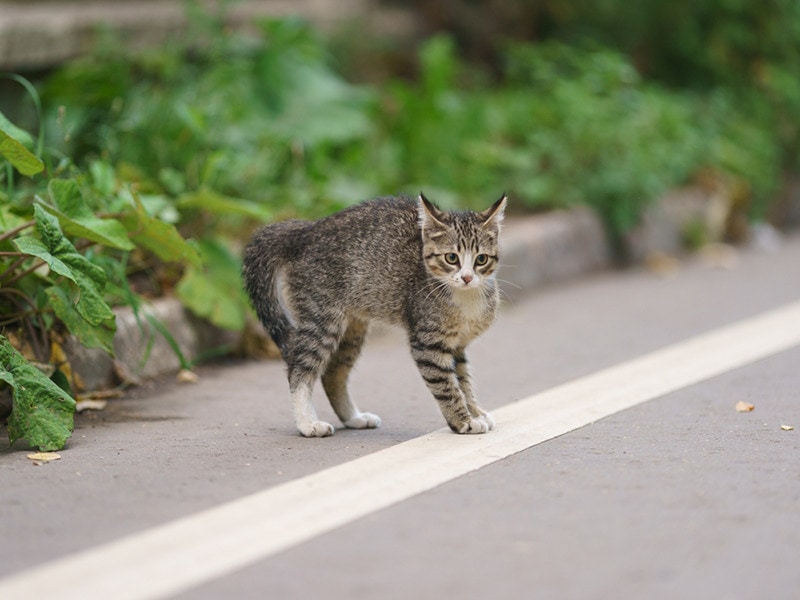Pet cats are very interesting, and they do a lot of different things for a lot of different reasons. Cats’ sideways movement, which is sometimes called “crab walking,” is the same and includes a number of behaviors with similar patterns of movement. Cats usually lock their legs together, arch their backs, and fluff up their tails before they hop or skip sideways. There are different reasons why your cat runs sideways, but before they start moving, they all stand with their legs straight, their back arched, and their tail fluffed.
Read on to understand what your cat may be up to when they skitter to the side.
As a cat owner, you’ve likely seen your feline friend scuttle sideways like a crab at some point. This funny, crab-like gait is common among cats and known as the “crab walk.” But why do cats move this way? There are several possible reasons cats do the crab walk.
What Is the Crab Walk?
The crab walk refers to when a cat walks sideways in a crouched position, keeping their belly low to the ground. Their legs remain partially bent, and they move their feet in unison to propel themselves sideways instead of forward.
Cats don’t walk this way all the time. The crab walk is a specific movement cats employ in certain situations. It allows them to move laterally while remaining in a crouched, defensive posture.
When performing the crab walk, a cat may scuttle just a few steps sideways or fully sprint from one side of the room to the other. Some cats crab walk frequently, while others hardly ever do it.
Why Cats Crab Walk
Cats don’t crab walk just for fun. This odd movement serves several purposes for our feline friends. Here are some of the main reasons cats scuttle sideways like crabs:
1. Playfulness
Kittens and energetic adult cats often crab walk during play The crab walk allows them to stay in a crouched, ready-to-pounce position while moving sideways to stalk or chase toys or other pets. It’s an exaggerated version of the posture cats use when hunting prey
You may see a playful cat crab walk toward you, especially if they want your participation in a game. It shows their eagerness to play and intent to pounce!
2. Practicing Motor Skills
Cats are natural athletes, capable of jumping, climbing, stalking, and more. Kittens especially need to practice movements like the crab walk to develop their balance, coordination, and motor skills.
Just like human infants learn to roll, sit up, and walk, kittens perfect various forms of cat locomotion through play. The more they walk like a crab, the better their muscles learn this lateral movement pattern.
3. Getting Attention
Cats crave attention from their beloved humans. A cat may crab walk toward you as a way to get you to notice them and interact. It’s a goofy, lighthearted means of saying “Hey, play with me!” or “Don’t forget about me over here!”
The crab walk allows them to approach you while staying ready to pounce or wrestle. It shows their interest in engaging with you.
4. Zoomies
During the frenetic random bursts of energy known as “the zoomies,” cats tear wildly around the house at top speed, bouncing off walls and furniture. The crab walk often features prominently during zoomies episodes as cats scramble sideways and every which way.
Scientists don’t know exactly why cats zoom, but it may be a form of stress release or pent-up energy. The crab walk provides cats with a way to burn energy fast during their zooming bouts.
5. Defensive Posturing
Cats also use the crab walk position to make themselves look bigger and intimidating when feeling threatened. If your cat crab walks away from something with their fur standing on end, bushy tail, back arched, and ears back, it signals fear or defensiveness.
The sideways stance allows cats to face the threat while moving away quickly. Remaining low to the ground also makes them a smaller target if attacked. It’s a defensive posture to protect against harm.
6. Marking Territory
By crab walking while rubbing, spraying, or scratching objects, cats can mark territory in a wider radius without having to stand up and make themselves vulnerable. It’s a way forcats to spread their scent while maintaining a protective body position.
An unneutered male cat may crab walk while spraying vertical surfaces as a territorial display. A threatened cat may also mark territory crab-style to claim an area as theirs for safety.
7. Medical Causes
While less common, certain medical conditions can sometimes cause a cat to lose coordination and wobble from side to side when trying to walk normally. In this case, the crab walk is not intentional but stems from medical issues like:
- Neurological disorders
- Inner ear infections
- Brain injuries
- Spinal cord disease
- Vestibular disease
- Cerebellar hypoplasia
- Metabolic disorders like diabetes
If your cat starts crab walking for the first time, especially if they seem off balance or unwell, see your vet to rule out an underlying medical cause.
How to Respond to Crab Walking
How should you react when your cat crab walks? That depends on the situation and your cat’s body language.
-
If your cat crab walks while playing, feel free to join in the fun! Chase them back, drag a toy along the floor for them to pounce on, or offer a teaser wand for them to hunt. Playtime crab walking is healthy bonding for you and kitty!
-
If your cat crab walks purposefully toward you, acknowledge them with affection to provide the attention they’re seeking. Pet them, offer a treat or toy, or pick them up for a cuddle.
-
If your cat seems fearful, anxious, or defensive while crab walking, leave them alone to calm down rather than interacting. Let them retreat to a safe space until they relax.
-
Zoomies crab walking is best not interrupted – just let your cat zoom and burn that energy!
-
If you suspect a medical reason, call your veterinarian to have your cat examined and diagnosed.
While a bit bizarre, the crab walk is completely normal and healthy feline behavior in most cases. With a better understanding of why cats scuttle sideways like crustaceans, you can better bond with your pet and respond appropriately when the crab walking starts!
Frequently Asked Questions
Why do cats crab walk during play?
Cats crab walk during play as a way to stay in a crouched, ready to pounce posture while moving. It allows them to stalk, chase, and maneuver easily when playing with toys or other pets. It’s an exaggerated hunting stance.
Is my cat playing or threatened when crab walking?
A playful crab walk involves movements toward you or toys and inviting body language like dilated pupils, upright tail, and chirps. A threatened crab walk involves movements away, arched back, bushy tail, and hisses or growls.
Should I be concerned if my older cat starts crab walking?
In older cats, new onset of crab walking can signify medical issues like neurological or ear disorders. Check with your vet if your senior cat takes up crab walking suddenly.
What does it mean when a cat crab walks away from another cat?
A cat that crab walks away from another cat with defensive body language is showing fear and trying to retreat while protecting itself. Never force interaction between two cats displaying this behavior.
Why does my cat only crab walk sometimes?
Most cats don’t crab walk frequently. They reserve it for specific situations like play or feeling threatened. If your cat only crab walks occasionally, that’s normal and not a cause for concern.
The Takeaway
Cats crab walk for a variety of reasons related to play, communication, territory marking, zoomies, and self-defense. It allows them to move sideways while staying in a protective crouch. While a bit silly looking, this unusual gait is entirely natural for cats. With proper insight into this behavior, cat parents can respond appropriately to their crab-walking kitty’s needs. Understanding the crab walk ultimately strengthens the bond between owner and cat.

Wary of Strangers
The posture of a cat that is scared is more extreme than the posture of someone who is wary of strangers. When a cat meets a new person, especially in their own home, they might be wary until they figure out what to do. As a safety measure, they might start to get ready by slowly moving to the side. This makes them bigger and ready to skedaddle if they need to. Without a direct threat, your cat probably won’t stay in this stance for long.
Either they will decide to leave the area until the stranger is gone, or they will let down their guard a bit while still keeping a safe distance. This will give them time to react if the stranger does something sudden or unexpected.
A cat that is angry and walks sideways is similar to a cat that is scared and walks straight ahead. The cat is clearly upset about something, but in this case, it seems to feel (or try to look) dominant. Like a scared cat, they want to let their enemy know that they are not to be messed with first. To do this, they do the same thing over and over again: they make themselves big by straightening their legs and tail and arching their back. But often there is a sense of menace to the cat’s action.
Instead of being perfectly straight, their tail might be flicking a little to show that they are annoyed, and their eyes are more focused. Their body language doesn’t show that they want to run away; it says, “Keep doing what you’re doing, and I’ll attack.” Of course, you probably won’t see your cat acting this way toward you, but if you do, pay close attention to what your pet is mad at.

Finally, neurological problems can sometimes cause your pet’s walking to be off, and your pet may look like it’s walking sideways because of this. These instances of a sideways walk aren’t associated with other forms of body language. In these situations, your cat isn’t necessarily trying to send a message; it’s just trying to walk or move (though in a strange and unsuccessful way). One neurological problem that can cause an abnormal gait is cerebellar hypoplasia. If your cat has this problem, it may look like it is taking wacky, uncoordinated steps. If you think your cat’s sideways walking is strange and doesn’t make sense, you should take them to the vet right away.
The 7 Reasons Why Your Cat is Running Sideways
Young cats and kittens, like other developing animals, can be very playful. There is usually something that grabs their attention. It could be a person, another cat or dog, or even a toy. As they get closer, they’ll get into the position by straightening their legs almost to the point of standing on tiptoes, arching their backs, and puffing out their fur below their tails. Once they find something they want to play with, they might move sideways around it and then suddenly dart in at an angle to play.
In this mode, your cat is probably already looking forward to playing and is ready to act silly. The move is similar to a dog’s universal dip-and-bow-before-play signal. Your cat is telegraphing that they are ready for fun and want to engage.
Sometimes felines have a surplus of energy—an abundance of bounce—that they need to burn off. This is especially important for kittens and young cats because they can get very loud when they play. When they’re in this mood, they run like crazy around the room, tearing from side to side and bouncing off the walls for no reason. It’s as if you’ve wound up a spinning top and released it to randomly careen around your home!.
This behavior looks like play, and your cat may be having fun, but this frenzy is different from play because it is random and doesn’t have a central focus or target. People often call this kind of play the “zoomies” because the cat moves quickly around the room. Cats often do some sideways running and jumping while they zoomies; it’s all part of the fun!

Sometimes cats love you and can’t get enough of you. For example, if you are typing on your laptop, they may want to sit on your keyboard. Cats also sometimes just want to be left alone and don’t want to be petted or cuddled. A slow sideways walk is one way they might show you that they want your attention. If you’ve responded to this behavior in the past with attention, it’s likely to happen again. Usually, the walk is initiated when they are already close to you before moving in even closer.
When they walk sideways to get your attention, their back is arched and their tail is long. Then they slowly bump into you and rub their back on you, probably on your legs. If your cat looks at you like this, it’s probably telling you that it wants to be close to you and would like some of your special rubs.
Strange as it seems, in felines, similar body language can have very different meanings. When a cat feels threatened and insecure, they often react with a variation of sideways movement. Firstly, they want to discourage the threat by presenting themselves as a tough adversary. These people do this by arching their backs and extending their legs to make themselves look bigger. They do this to show how big they could get. Likewise, their tail will fan up and stiffen. When you see a scared cat, it’s almost like they’ve been shocked; their claws are even spread out to give them an extra boost.
When cats show a possible threat why they shouldn’t be feared, they may move sideways away to get some distance between themselves and the source of their fear. Generally, the movement is measured and controlled; the cat doesn’t want to trigger a response. Instead, they will wait until they are some distance away from the threat before suddenly turning around and running away.

